
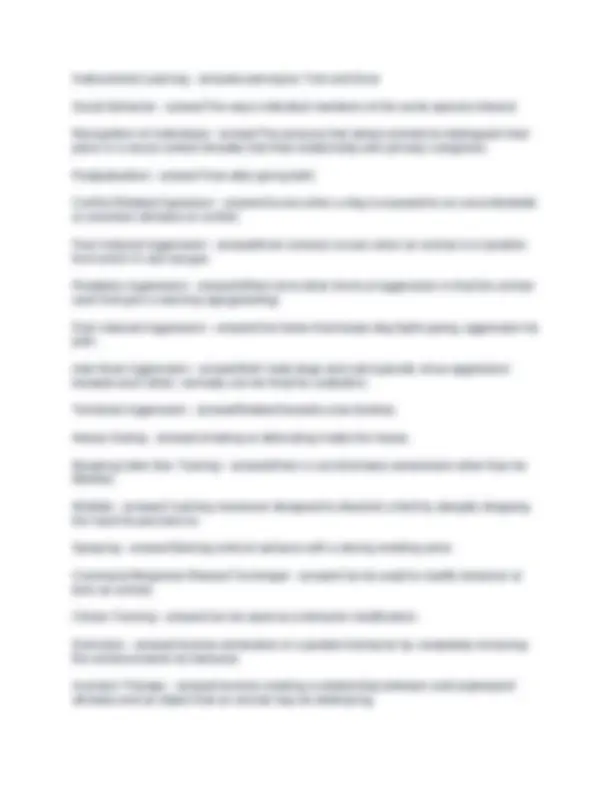
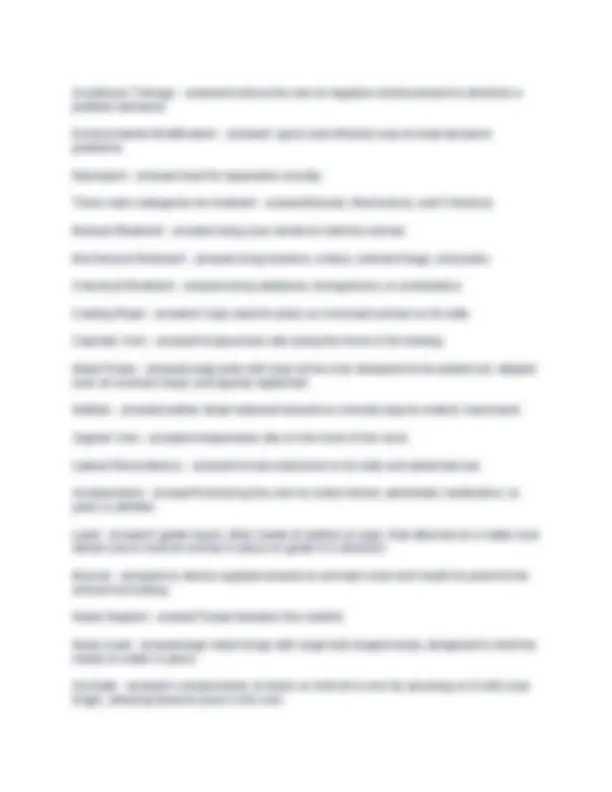
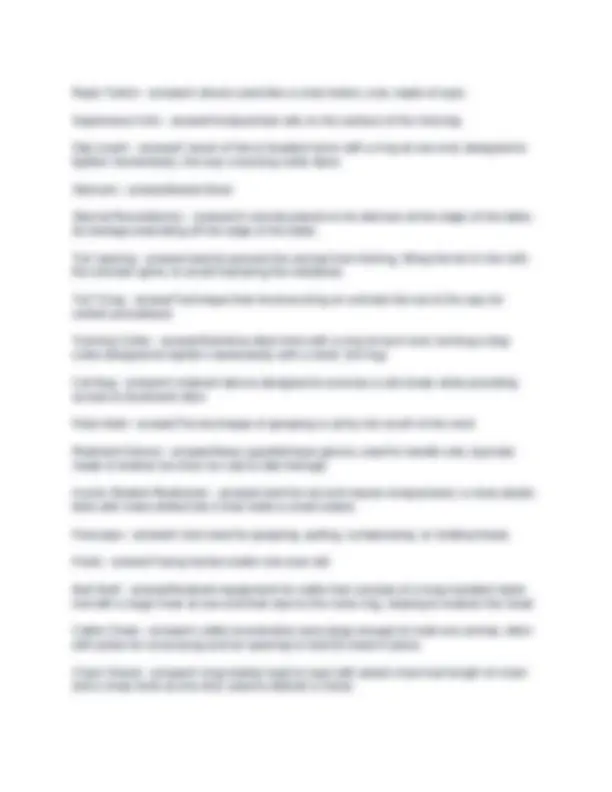
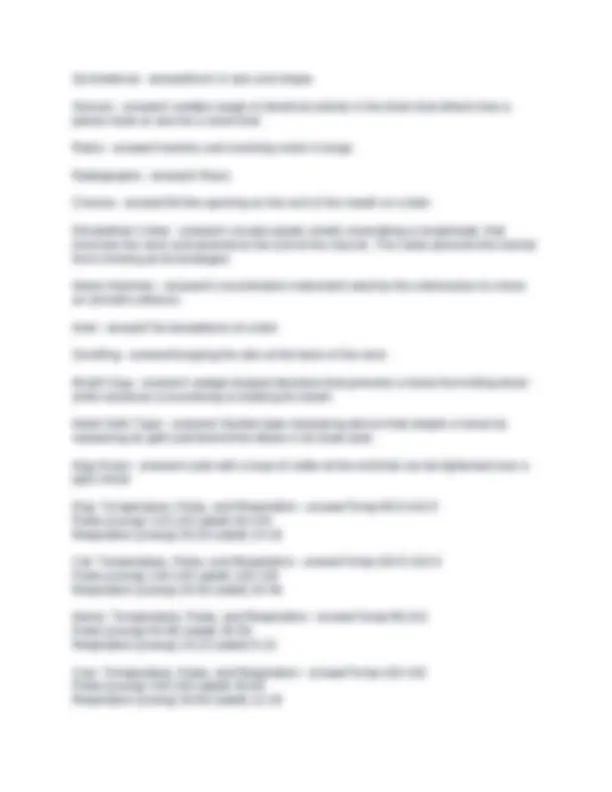
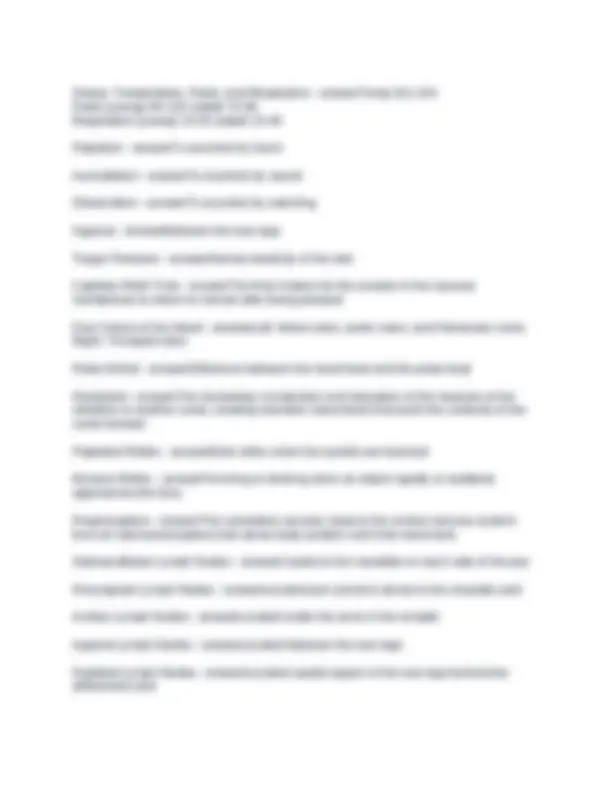
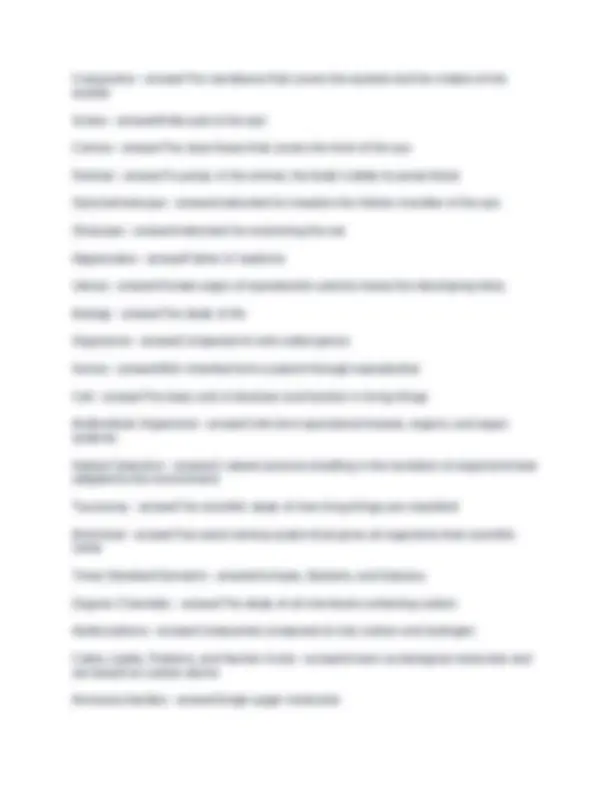

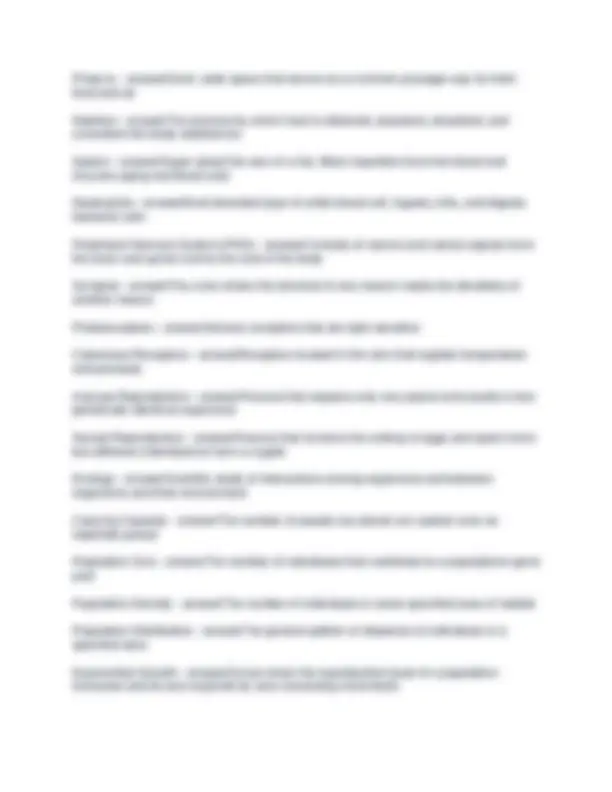
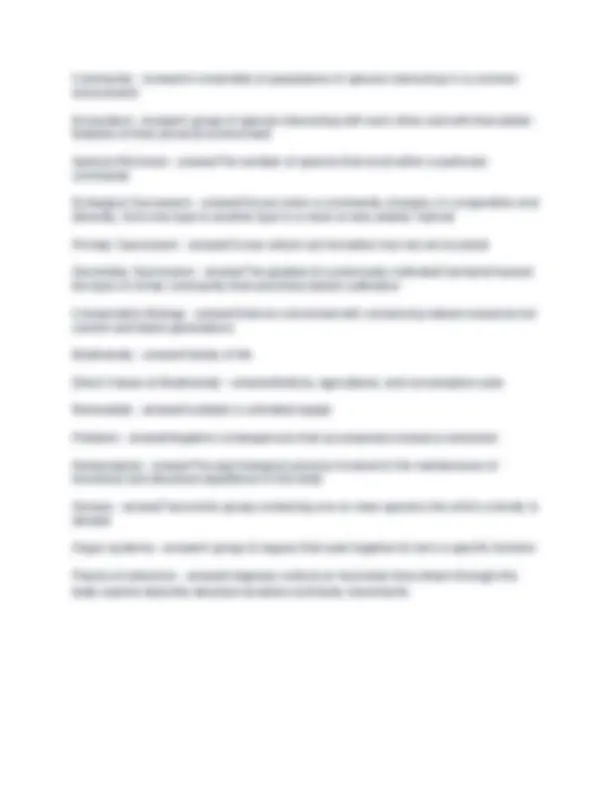


Study with the several resources on Docsity

Earn points by helping other students or get them with a premium plan


Prepare for your exams
Study with the several resources on Docsity

Earn points to download
Earn points by helping other students or get them with a premium plan
Community
Ask the community for help and clear up your study doubts
Discover the best universities in your country according to Docsity users
Free resources
Download our free guides on studying techniques, anxiety management strategies, and thesis advice from Docsity tutors
Penn Foster Semester 1 Study Questions and Answers 100% Correct
Typology: Exams
1 / 15

This page cannot be seen from the preview
Don't miss anything!










Ethology - answer Signifies the science of character. Evolution - answer Natural process of slow change and development that gradually leads to new species of plants and animals. Species - answer Classification given to a group of animals who can produce young. Classical Ethology - answer Asserts that much of what animals know is instinctive or innate Animal psychology was founded on? - answer Pavlov’s discovery that animals could learn to build novel associations between various stimuli. Behaviorism - answerBehavior is learned rather than genetically programmed. Stimulus Response Theory - answerAll complex forms of behavior, including emotions, thoughts, and habits, are complex muscular and glandular responses that can be observed and measured. Stimulus Responses are... - answerMuscular and glandular responses. Classical Conditioning - answerThe association of stimuli that happens at approximately the same time. Operant Conditioning - answerThe association of an activity with punishment or reward. Sociobiology - answerThe study of the biological basis of social behavior. Instinct - answerAn animals natural and inherent ability to perform such tasks as hunting, feeding, and mating. Positive Reinforcement - answerRefers to any immediate pleasant occurrence used to create desired behavior. Negative Reinforcement - answerRefers to any immediate unpleasant occurrence used to create a desired behavior. Imprinting - answerA rapid learning process that enables the very young to recognize and bond with their caretaker. Sensitive Period - answerPeriod of time when imprinting occurs.
Conditioned Stimulus - answerSensory input unrelated to a simple reflex behavior. Unconditioned Stimulus - answerSensory input that produces a simple reflex behavior. Fixed Action Patterns - answerA term used by early ethologists to describe stereotypical or predictable behaviors of a species. Function - answerSurvival Rate. Naturalist - answerNatural scientists. Nature-Nurture Controversy - answerThe crux of two opposing schools: Classical Ethology and Animal Psychology. Unconditioned Response - answerA simple reflex behavior. Operant - answerFunctioning or tending to produce effect. Charles Darwin - answerRevolutionized much of the study of biology and ethology with his theory of evolution and he believed that animal behavior was generated by instinct. Ivan Pavlov - answerChallenged the notion of animal behavior being purely instinctual. Behaviorism - answerOriginated with American Psychologist John B Watson, who formulated Stimulus Response Theory. Punishment - answerAn unpleasant occurrence used to eliminate an undesirable behavior. Positive Punishment - answerAdding an unpleasant occurrence at the time of a behavior to stop it. Negative Punishment - answerRemoving the desired end result to stop a behavior. When is the animals socialization period? - answerCat is 2-8 weeks Dogs is 4-14 weeks Aggression - answerBehavior bred from an impulse to harm another being. Dance - answerComplex pattern of movements performed by a bee that directs other bee's to food. Habituation - answerThe process of learning that certain objects and events have little bearing on survival and can thus be ignored.
Avoidance Therapy - answerInvolves the use of negative reinforcement to diminish a problem behavior. Environmental Modification - answerA quick and effective way to treat behavior problems. Diazepam - answerUsed for separation anxiety. Three main categories for restraint - answerManual, Mechanical, and Chemical. Manual Restraint - answerUsing your hands to hold the animal. Mechanical Restraint - answerUsing leashes, collars, restraint bags, and poles. Chemical Restraint - answerUsing sedatives, tranquilizers, or anesthetics. Casting Rope - answerA rope used to place an enclosed animal on its side. Cephalic Vein - answerVenipuncture site along the front of the foreleg. Head Snare - answerLarge pole with loop at the end, designed to be pulled out, slipped over an animals head, and quickly tightened. Hobble - answerLeather strap fastened around an animals legs to restrict movement. Jugular Vein - answerVenipuncture site on the front of the neck. Lateral Recumbency - answerAnimal restrained on its side and stretched out. Venipuncture - answerPuncturing the vein to collect blood, administer medication, or pass a catheter. Lead - answerA guide leash, often made of leather or rope, that attaches to a halter and allows you to hold an animal in place or guide it in direction. Muzzle - answerAny device applied around an animals nose and mouth to prevent the animal from biting. Nasal Septum - answerTissue between the nostrils. Nose Lead - answerlarge metal tongs with large ball-shaped ends, designed to hold the heads of cattle in place. Occlude - answerIn venipuncture, to block or hold off a vein by pressing on it with your finger, allowing blood to pool in the vein.
Rope Twitch - answerA device used like a chain twitch, only made of rope. Saphenous Vein - answerVenipuncture site on the surface of the hind leg. Slip Leash - answerA leash of flat or braided nylon with a ring at one end, designed to tighten momentarily, the way a training collar does. Sternum - answerBreast Bone Sternal Recumbency - answerAn animal placed on its sternum at the edge of the table, its forelegs extending off the edge of the table. Tail Jacking - answerUsed to prevent the animal from kicking, lifting the tail in line with the animals spine, to avoid fracturing the vertebrae. Tail Tying - answerTechnique that involves tying an animals tail out of the way for certain procedures. Training Collar - answerStainless-steel links with a ring at each end, forming a dog collar designed to tighten momentarily with a short, firm tug Cat Bag - answerA restraint device designed to enclose a cat's body while providing access to treatment sites Fetal Hold - answerThe technique of grasping a cat by the scruff of the neck Restraint Gloves - answerHeavy gauntlet-type gloves, used to handle cats, typically made of leather too thick for cats to bite through. Acrylic Rodent Restrainer - answerUsed for rat and mouse venipuncture; a clear plastic tube with holes drilled into it that holds a small rodent. Foreceps - answerA tool used for grasping, pulling, compressing, or holding tissue. Foals - answerYoung horses under one year old. Bull Staff - answerRestraint equipment for cattle that consists of a long-handled metal rod with a large hook at one end that clips to the nose ring, helping to restrain the head. Cattle Chute - answerA cattle examination area large enough to hold one animal, often with poles for cross-tying and an opening to hold its head in place. Chain Shank - answerA long leather lead or rope with about a two-foot length of chain and a snap hook at one end, used to distract a horse.
Gastrointestinal System - answerAlso known as the digestive system, extends from the mouth to the anus, and responsible for digestion and elimination. Urinary System - answerKidneys, ureters, urinary bladder, urethra. Reproductive System - answerReproduce offspring- produce male sex cells (sperm) and female sex cells (oocytes). Musculoskeletal System - answerThe bones and voluntary muscles of the body. Central Nervous System - answerBrain and spinal cord. Intervertebral Disk Disease - answerDeteriorated cushions between the vertebrae. Alopecia - answerHair loss. Bilateral - answerBoth sides. Caudal - answerToward the tail. Comedones - answerAlso called blackheads; masses of sebum trapped in the hair follicles. Cranial - answerToward the head. Dorsal - answerToward the back. Erythroderma - answerRedness of the skin. Papule - answerSmall, solid, raised lesion on surface of the skin. Papillae - answerA pimple-like structure that can be found in the ear canal, choana, etc. Nares - answerNostrils. Medial - answerToward the middle. Jugular Venipuncture - answerThe taking of a blood sample from the jugular vein of an animal. Ventral - answerToward the front. Tympanic Membrane - answerCovers the ear drum. Thoracic Area - answerThe chest cavity of an animal.
Symmetrical - answerEven in size and shape. Seizure - answerA sudden surge of electrical activity in the brain that affects how a person feels or acts for a short time Rales - answerCrackles; wet crackling noise in lungs. Radiographs - answerX-Rays. Choana - answerSlit like opening on the roof of the mouth on a bird. Elizabethan Collar - answerA circular plastic shield, resembling a lampshade, that encircles the neck and extends to the end of the muzzle. The collar prevents the animal from chewing at its bandages. Neuro Hammer - answerAn examination instrument used by the veterinarian to check an animal's reflexes. Keel - answerThe breastbone of a bird Scruffing - answerGrasping the skin at the back of the neck Mouth Gag - answerA wedge-shaped structure that prevents a horse from biting down while someone is examining or treating its mouth Heart Girth Tape - answerA flexible tape measuring device that weighs a horse by measuring its girth just behind the elbow in its heart area Hog Snare - answerA pole with a loop of cable at the end that can be tightened over a pig's snout Dog: Temperature, Pulse, and Respiration - answerTemp:99.5-102. Pulse:(young) 110-120 (adult) 60- Respiration:(young) 20-25 (adult) 14- Cat: Temperature, Pulse, and Respiration - answerTemp:100.5-102. Pulse:(young) 130-140 (adult) 100- Respiration:(young) 20-30 (adult) 20- Horse: Temperature, Pulse, and Respiration - answerTemp:99- Pulse:(young) 60-80 (adult) 30- Respiration:(young) 14-15 (adult) 9- Cow: Temperature, Pulse, and Respiration - answerTemp:100- Pulse:(young) 100-150 (adult) 40- Respiration:(young) 30-60 (adult) 12-
Conjunctive - answerThe membrane that covers the eyeball and the insides of the eyelids Sclera - answerWhite part of the eye Cornea - answerThe clear tissue that covers the front of the eye Perfuse - answerTo pump; in the animal, the body's ability to pump blood Ophyhalmoscope - answerInstrument to visualize the interior chamber of the eye Otoscope - answerInstrument for examining the ear Hippocrates - answerFather of medicine Uterus - answerFemale organ of reproduction used to house the developing fetus. Biology - answerThe study of life Organisms - answerComposed of cells called genes Genes - answerDNA inherited from a parent through reproduction Cell - answerThe basic unit of structure and function in living things Multicellular Organisms - answerCells form specialized tissues, organs, and organ systems Natural Selection - answerA natural process resulting in the evolution of organisms best adapted to the environment. Taxonomy - answerThe scientific study of how living things are classified Binominal - answerTwo-word naming system that gives all organisms their scientific name Three Standard Domains - answerArchaea, Bacteria, and Eukarya Organic Chemistry - answerThe study of all chemicals containing carbon Hydrocarbons - answerCompounds composed of only carbon and hydrogen Carbs, Lipids, Proteins, and Nucleic Acids - answerKnown as biological molecules and are based on carbon atoms Monosaccharides - answerSingle sugar molecules
Disaccharides - answerComposed of two monosaccharides that are bonded together Polysaccharides - answerCarbohydrates that are made up of more than two monosaccharides Lipids - answerEnergy-rich organic compounds, such as fats, oils, and waxes, that are made of carbon, hydrogen, and oxygen. Saturated Fatty Acids - answerHave the maximum number of hydrogen atoms possible and no double bonds Unsaturated Fats - answerA fat that is liquid at room temperature and found in vegetable oils, nuts, and seeds. Phospholipids - answerA molecule that is a constituent of the inner bilayer of biological membranes, having a polar, hydrophilic head and a nonpolar, hydrophobic tail. Keratin - answerHair and fingernails Collagen - answerSkin and tendons Enzymes - answerMetabolism Hemoglobin - answerRed blood cells; transports oxygen Antibodies - answerDisease protection Hormones - answerCommunications of cells; glucose Actin and Myosin - answerMuscle cells contract and relax Peptide Bond - answerFormed when an amino group bonds covalently to a carboxyl group Peptide - answerMade of two or more amino acids joined together by covalent bonds Polypeptide - answerMolecule that consists of many amino acids connected by peptide bonds Covalent Bonding - answerOccurs when each of two atoms has an unpaired electron in its outer electron shell Ionic Bonding - answerOccurs when atoms either donate or accept electrons from another atom
Nonvascular Plants - answerPlants that have no vascular tissue, instead they use rhizoids for absorbing water and solutes Vascular Plants - answerPlants with roots, stems, and leaves Fungi - answerNon-green, heterotrophic organisms that grow in dark, moist habitats Invertebrates - answerAnimals without backbones Sponges - answerMulticellular animals that do not display any type of symmetry, organized tissue, or organs Hominids - answerMammals that have an anatomy suitable for standing erect and walking on two feet Xylem - answerVascular tissue of a plant that conducts water and dissolves minerals through the plant body Phloem - answerVascular tissue of a plant that conducts sugars and other solutes throughout the plant Perennial Plants - answerPlants that can outlast winter because their roots can survive to produce new shoots in the spring Auxin - answerA plant hormone that soften cell walls to allow growth Stamen - answerMale reproductive part of a flower Tissues - answerGroups of similar cells performing particular functions, like motility or respiration Platelets - answerFragments of larger cells that are present only in bone marrow; assist with the clotting process Red Blood Cells - answerTransport oxygen for aerobic respiration and carry away some of the carbon dioxide wastes White Blood Cells - answerPatrol tissue and engulf damaged or dead cells and anything recognized as foreign to the body Respiration - answerThe process by which animals move oxygen into blood and rid the body of accumulated carbon dioxide wastes Inhalation - answerThe active process in which air enters the lungs
Pharynx - answerShort, wide space that serves as a common passage way for both food and air Nutrition - answerThe process by which food is obtained, prepared, absorbed, and converted into body substances Spleen - answerOrgan about the size of a fist, filters impurities from the blood and recycles aging red blood cells Neutrophils - answerMost abundant type of white blood cell; ingests, kills, and digests bacterial cells Peripheral Nervous System (PNS) - answerConsists of nerves and carries signals from the brain and spinal cord to the rest of the body Synapse - answerThe zone where the terminal of one neuron meets the dendrites of another neuron Photoreceptors - answerSensory receptors that are light sensitive Cutaneous Receptors - answerReceptors located in the skin that register temperature and pressure Asexual Reproduction - answerProcess that requires only one parent and results in two genetically identical organisms Sexual Reproduction - answerProcess that involves the uniting of eggs and sperm from two different individuals to form a zygote Ecology - answerScientific study of interactions among organisms and between organisms and their environment Carrying Capacity - answerThe number of people our planet can sustain over an indefinite period Population Size - answerThe number of individuals that contribute to a populations gene pool Population Density - answerThe number of individuals in some specified area of habitat Population Distribution - answerThe general pattern of dispersal of individuals in a specified area Exponential Growth - answerOccurs when the reproduction base of a population increases and its size expands by ever-increasing increments